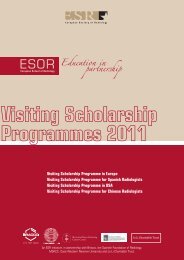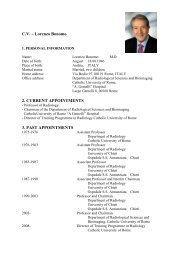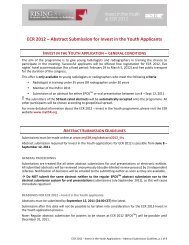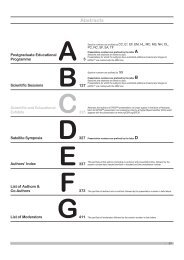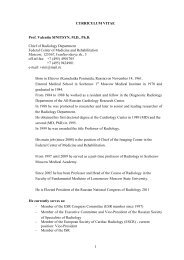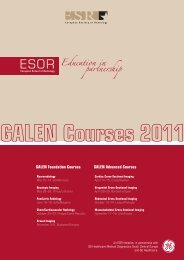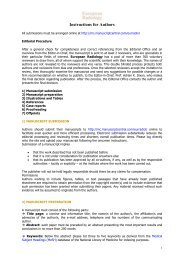Postgraduate Educational Programme - myESR.org
Postgraduate Educational Programme - myESR.org
Postgraduate Educational Programme - myESR.org
- No tags were found...
Create successful ePaper yourself
Turn your PDF publications into a flip-book with our unique Google optimized e-Paper software.
<strong>Postgraduate</strong> <strong>Educational</strong> <strong>Programme</strong>A-082 08:48Preparing your menuJ. Biederer; Heidelberg/DE (Juergen.Biederer@med.uni‐heidelberg.de)Compared to other lung imaging modalities, magnetic resonance imaging mightbe considered complex and difficult to use in clinical routine at first sight. However,in practice, the application is facilitated by dedicated, pre-set protocol trees customizedfor typical clinical questions. The procedures are simplified by avoidingECG triggering or other time-consuming preparations for the examination. A basicprotocol to be acquired within less than 15 min without administration of contrastmaterial covers most clinical problems including infiltrates and lung nodules almostequally to CT. Excellent soft tissue contrast facilitates tumour staging, e.g. thedifferentiation of tumour and atelectasis or the diagnosis of mediastinal and chestwall masses. Visualisation of respiratory motion contributes functional information.Additional, contrast-enhanced series to be acquired within 5 more minutes increasethe sensitivity of the examination for the detection of tumour necrosis and pleuralreaction/carcinosis. A dedicated protocol for the diagnosis of pulmonary embolismcan be acquired within 15 min. This comprises an initial, free breathing and noncontrast-enhancedexamination for quick detection of severe embolism combinedwith dynamic contrast-enhanced perfusion imaging, a high-resolution angiogramand a final 3D breath-hold acquisition. These pre-set protocols offer solutions fortricky problems of daily routine, in the lungs and the chest wall as well as for imagingthe mediastinum, or for cases in which radiation exposure or administrationof CT contrast material should be strictly avoided, e. g. in paediatrics, pregnantwomen or for scientific studies.Learning Objectives:1. To learn how to combine MR sequences with a comprehensive imaging protocol.2. To become familiar with the different diagnostic scopes of the protocol components.3. To learn how to apply protocol variations for specific clinical questions.4. To learn when to use IV contrast-enhanced series.Author Disclosure:J. Biederer: Speaker; Siemens.A-083 09:03Bon appétit! Starters”: cystic fibrosis, pneumonia and pulmonaryembolismM.U. Puderbach; Heidelberg/DE (m.puderbach@dkfz.de)CF: MRI is comparable to CT with regard to the detection of relevant morphologicalchanges in the CF lung. Compared to CT, the strength of MRI is the additional assessmentof „function“, i.e. perfusion, pulmonary haemodynamics and ventilation.In CF, regional ventilatory defects cause changes in regional lung perfusion dueto the hypoxic vasoconstriction response or tissue destruction. Using dynamiccontrast-enhanced MRI, these perfusion changes can be assessed. Pulmonaryembolism: The current imaging reference technique in evaluation of acute pulmonaryembolism is helical computed tomography. To be competitive with CT, anabbreviated MR protocol focusing on lung vessel imaging and lung perfusion maybe accomplished within 15 min in-room time. As a first step, a steady-state GREsequence acquired in two or three planes during free breathing enables a noncontrast-enhanceddetection of large central emboli. As a second step, the protocolcontinues with the contrast-enhanced steps including first pass perfusion imaging,high spatial resolution contrast-enhanced (CE) MRA and a final acquisition witha volumetric interpolated 3D FLASH sequence in transverse orientation. Pneumonia:The potential of MRI to replace chest radiography, particularly in children,was already investigated several years ago. The experience from this work maybe considered valid for the suggested protocols for 1.5-T scanners since imagequality has significantly improved. Therefore, T2-weighted fat-suppressed as wellas dynamic contrast-enhanced T1-GRE sequences are applied with a slice thicknessbetween 5 and 6 mm. Disease entities encompassing community-acquiredpneumonia, empyema, fungal infections and chronic bronchitis are detectable.Learning Objectives:1. To understand the application of MRI to morphological and functional imagingof airway diseases.2. To appreciate the potential of MRI for imaging pulmonary embolisms usingdifferent morphological and functional MR-techniques.A-084 09:23Bon appétit! Main course”: pulmonary and mediastinal neoplasmsE.J.R. van Beek; Edinburgh/UK (edwin‐vanbeek@ed.ac.uk)CT remains one of the main tools for the diagnosis of pulmonary and mediastinalneoplasms. In addition, PET imaging (with or without CT) plays an integral rolein planning therapy due to its ability to enhance the staging requirements prior totreatment planning. However, MRI has made significant inroads into aiding treatmentdecisions and planning. MRI is the mainstay in the management of superior sulcustumours, tumours where chest wall invasion is suspected and for characterisationof mediastinal tumours. It is now increasingly able to detect, assess and giveadditional (functional and often more detailed anatomical) information. The useof standard high-spatial resolution imaging in combination with the application ofstandard and dynamic contrast-enhanced imaging and the utility of ultrafast imagingdemonstrating motion of <strong>org</strong>ans and structures of the chest wall and diaphragmfurther enhance the capability of MRI. Thus, although still mainly reserved as atool for “difficult cases”, it is very likely that MRI will play an increasingly importantrole in the diagnosis and staging of chest tumours, ranging from lung cancer tomediastinal and pleural processes. This presentation will give examples of benignand malignant processes, linking this with the previously demonstrated menu ofsequences now available.Learning Objectives:1. To understand the application of MRI sequences to the staging of lung cancer.2. To become familiar with the role of MRI in lung cancer work-ups.3. To learn about the limitations of MRI in chest tumours.Author Disclosure:E. J. R. van Beek: Advisory Board; Siemens Lung MRI. CEO; QuantitativeClinical Trials Imaging Services, Inc. Speaker; Toshiba Medical Systems, VitalImages.Panel discussion:“Bon appétit! Dessert”: what are the benefits of MRI of the lung inclinical workflow and decision-making? 09:4308:30 - 10:00 Room G/HNeuroRC 411The paediatric brain: not just a small brainModerator:C. Venstermans; Edegem/BEA-085 08:30A. Neurocutaneous syndromes: more than neurofibromatosisB. Ertl‐Wagner; Munich/DE (Birgit.Ertl‐Wagner@med.uni‐muenchen.de)Neurofibromatosis type 1 is the most common, but certainly not the only neurocutaneoussyndrome. In children, white matter signal alterations (“myelin vacuoles”) area common neuroimaging finding. The incidences of optic gliomas and other gliomasare increased. Neurofibromas can occur in almost any body region. Plexiform neurofibromasshow a diffuse and often locally destructive growth. Neurofibrosarcomasare malignant nerve sheath tumours. Neurofibromatosis type 2 is characterisedby acoustic neuromas (vestibular schwannomas), which can be uni- or bilateral.Schwannomas can also affect other cranial nerves and spinal nerves. The incidencesof meningiomas and to a lesser extent of gliomas are also increased. Thehallmark feature of tuberous sclerosis is the combination of cortical or subcorticaltubers and subependymal nodules. Tubers are hyperintense on T2w and FLAIRsequences. Other than heterotopia, subependymal nodules are NOT isointenseto gray matter. Giant cell astrocytomas are located at the foramina of Monroi, increasein size over time and show a contrast enhancement. Sturge-Weber disease(encephalotrigeminal angiomatosis) is characterised by a leptomeningeal angiomaand facial naevus flammeus. There is increased leptomeningeal enhancementand hypertrophy of the ipsilateral choroid plexus. Atrophy of the affected regionand tramtrack calcifications typically ensue. Von Hippel-Lindau disease is not aneurocutaneous syndrome per se, but was classically considered a phakomatosis.Typical features include haemangioblastomas of the brain, spinal cord or retina, andpapillary cystadenomas of the endolymphatic sac. Most neurocutaneous syndromeshave manifestations outside the central and peripheral nervous systems as well.Moreover, there are multiple rare neurocutanteous syndromes.Learning Objectives:1. To become familiar with the typical clinical presentations of neurocutaneoussyndromes.S26AB C D E F G



